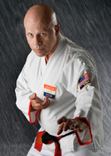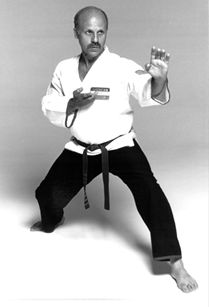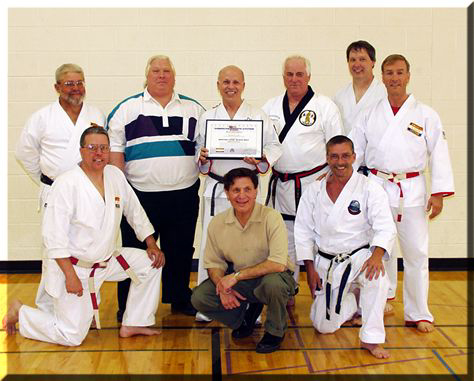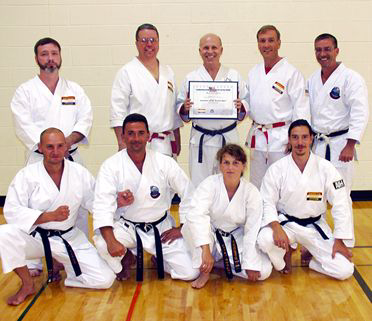Thank you for your interest in the A.K.S. After reading this brief history, it's our hope that you will have a better understanding and appreciation of, and for, our organization. We would enjoy hearing from interested parties regarding our philosophies and goals. If you are of the same mind and would like to visit with us about the possibilities of membership, we invite you to email any of the CONTACT individuals. Please note that the historical information included below was acquired by reviewing various books on the subject. If there are any inaccuracies, we would be most appreciative if you would let us know. We are interested in being as accurate as is possible to ensure the proper information is provide to those who journey these pages.
The American Karate System is the brainchild, and dream come true, of the late Mr. Ernest H. Lieb, the system's founder, and a 10th Degree Black Belt. While conducting an A.K.S. seminar in Germany, Ernie, SFC Charles Krum, 5th DAN A.K.S. and two German A.K.S. students, Mattheas Augustijn, and Dagmar (Daggi) Wichterich were tragically killed in a maglev (magnetic levitation) train accident in Lathen, Germany on September 22, 2006. It is our intent to carry on with Ernie's hopes and dreams for the American Karate System.
Ernie's Story <--Click Here
Historical Perspective on the Origins of Karate
The beginnings of the martial arts cannot be accurately traced. As early as the days of the cave dweller man has sought weapons and techniques with which to defend himself or to conquer his enemies. For the purposes of brevity we'll begin with what is believed to be the origin of Kung-Fu.
Various martial arts publications tell us that about fourteen hundred years ago the founder of Zen Buddhism, Daruma (Bodhidharma), left his native country of India and traveled to China to present lectures on Buddhism. He eventually settled in the Hunan Province in a place of worship known as the Shaolin Temple. Once there his following, which had grown to a large number, were led through rigorous training which caused many to drop out from exhaustion. Daruma developed a set of exercises for them called the "Ekkin Sutra." Through these movements, his followers were able to regain their physical strength, and soon became known far and wide for their courage and fortitude. These movements were combined with local techniques to form the Chinese system of boxing, or Kung-Fu.
Korea, Japan and Okinawa each had martial arts systems unique to their native lands. As countrymen traveled to and from their homeland and China, they brought back new and different techniques. Karate, as we know it, originated in Okinawa and was brought to Japan by Ginchin Funakoshi in 1917. Funakoshi's travel to Japan, at that time, was to demonstrate his martial art to the Emporer of Japan. This trip was made possible by an invitation from the Ministry of Education. After giving his demonstrations and lectures, Funakoshi returned to his Okinawan homeland. He returned again to Japan in 1923 and continued teaching his system of karate. He remained there until his death in 1957.
Evolution of Modern Karate
Before beginning our discussion of the A.K.S., we must first understand how many of the present day systems of martial arts have evolved. So as to not become overly engulfed in the many examples, only five systems will be discussed. The following examples do not fall in any particular order.
The first is the Wado Ryu System. The founder, Sensei Hironori Otsuka, was a master of the Shindo-Yoshin Jujitsu Ryu and had studied under O'Sensei Funakoshi. Sensei Otsuka combined his knowledge of Jujitsu and karate to create the Wado Ryu system. The culmination of Sensei Otsuka's Wado Ryu endeavors was his development of rules and regulations for free sparring (fighting) in 1934.
The second style is Shito-Ryu. This system was devised by Sensei Kenwa Mabuni. Sensei Mabuni was born in Okinawa in 1893 and studied under Masters Itosu and Higaonna, both instructors with whom O'Sensei Funakoshi had studied. Itosu and Higaonna were two of Okinawa's most renowned proponents of the islands three main systems of martial arts. By combining the teachings of Itosu and Higaonna, Mabuni created Shito-Ryu.
As we've discussed Funakoshi at the beginning of this introduction, it would only be fitting to talk about his system. Probably the most widely known system throughout the world is Shotokan. Though not called Shotokan until the mid 1930s, this system of karate has followers on every continent of the world. O'Sensei Funakoshi also combined teachings from several of his instructors, two of whom were mentioned above. Shotokan translates to "Shoto's way." Shoto was the pen name Funakoshi used when he wrote poetry.
For the last two systems, we move to Korea. The Korean form of Karate was called T'ang su around 337 A.D., and under went several changes from Subak, to Tae Kwon and Kwon Pup until it became the present day style of Tae Kwon Do. This was due to the liberation of Korea in 1945, and under the direction of General Choi Hon Hi.
Lastly, the Korean system of self-defense called Hapkido has roots that transcend both the earliest systems of Tae Kwon Do and the Japanese system of Jujitsu. A Korean traveled to Japan in 1910 to study the Daito system of Aikijujitsu. The Korean student, Yong Shul Choi, was in the same class with a young Japanese student name Morihei Uyeshiba. O'Sensei Uyeshiba developed and organized a school of Aikijujitsu in 1945 that later evolved into modern day Aikido. Also in 1925, Choi returned to Korea and combined the styles of Aikijujitsu and Tang Su Do, thus creating Hapkido.

The American Karate System: A Historical Perspective
The American Karate System is the realization of a dream and ideas that began in the mind of its founder, Ernest H. Lieb, upon his return from Korea in 1964. One of Mr. Lieb's first dreams was an organization that was not dedicated to any one style or system of martial art, but made up of a variety of them. His dream was an organization which promoted sharing and brotherhood, as opposed to senseless rivalry, bickering, and competition over whose style or school was the best.
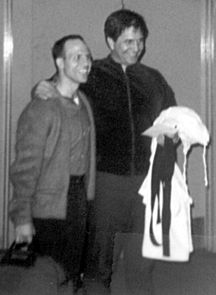
Picture was taken at J. Rhee's Washington DC tournament in 1967 - (left to right) Ernie Lieb and Ed Parker.
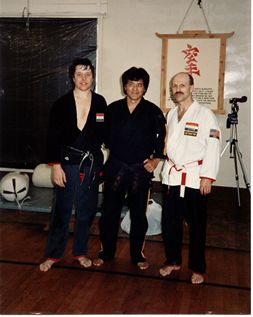
(left / right) Fred Reinecke, Tadashi Yamashita, and Ernie Lieb at Mr. Yamashita's clinic in Grand Rapids, Michigan in 1989.
In order to put this into perspective, for those readers whose knowledge and experience in the martial arts encompasses only the past decade or two, we must examine some of the rivalries that existed. Only one example will be used, though others are available.
Probably the most infamous was John Keehan, alias "Count Dante." He professed to be the most deadly man alive, and advertised as such in a variety of periodicals of the day. The rumors and infighting that were instigated by Keehan within some of the Chicago schools of the early and middle 1960s, resulted in street fights and attacks by one school on another. Many injuries and at least one death were attributed to these clashes. It was this torrid environment that Ernie Lieb hoped to change.
It was Mr. Lieb's belief, based on his training in the martial arts, that karate and other forms of martial training were not meant to foster violence. On the contrary, the martial arts are intended to provide practitioners with discipline and self-confidence in their ability to defend themselves and their loved ones. Training, properly followed, would over time provide the serious practitioner of a particular art the ability to arrive at a state of mental and spiritual harmony and well being.
For this to occur, all the schools, regardless of style or origin, had to be willing to share and accept each other as brothers and sisters within the family of the martial arts. Thus allowing students at all levels to concentrate on training in its truest sense, as opposed to the preoccupation on who was going to bust whose head to prove who was or was not the best.
From this sprang the American Karate Association (AKA) which Mr. Lieb founded in 1964. The AKA today is one of the stronger karate associations in America.
This was not the end. Mr. Lieb still envisioned a truly American style of karate. A style that would accommodate the American physical structure and mentality, but with its foundation coming from the main oriental systems. The second dream began with the American Chi Do Kwan system. As Ernie's following grew, so did the realization that the system would never truly be American as long as an oriental name preceded or followed the word American.
With 13 of Ernie Lieb's key instructors, representing 13 different schools and locations, the American Karate System was born. This took place at the first A.K.S. summer camp in Muskegon, Michigan in August of 1973. Since then the system has gone through many changes and growing pains. Not all of the original instructors remain with the A.K.S. today. Those who do remain, form the nucleus, foundation, and belief instilled early on by Mr. Lieb, that the American Karate System was to be an eclectic style using anything that works, while discarding that which didn't. This approach, in and of itself, sets the American Karate System apart from all other oriental systems. For several decades, all the oriental systems would only teach and train in the fashion in which their founder had originally taught. Some styles have come to realize they must change to keep up with the ever evolving creativeness of the many Americans practicing in the United States.
Although not all are members of the A.K.S., many of these practitioners exude the open minded creative approach that puts Americans in the winning circle more times than not.
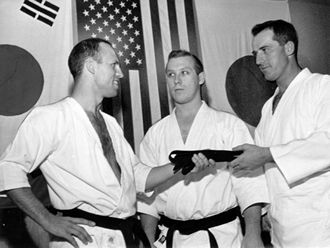
Pictured (L-R) are Ernie Lieb, Carl Stolberg, and Monte Beghtol at one of Mr. Lieb's early black belt promotions during the middle 1960s.
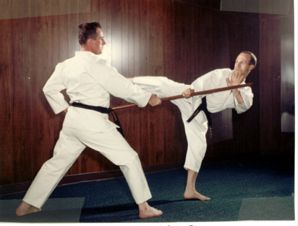
Mr. Lieb conducting a Bo demonstration with Mr. Beghtol.
The American Karate System
So what is this system of karate called the American Karate System? It's a system of techniques and strategies which are geared to provide a person with a means to effectively defend themselves in the event of a personal attack. It employs blocks, punches, jabs, kicks, throws, joint locks, and breaks that can neutralize an attacker in the blink of an eye. It's a system by which a person can condition their body physically and mentally arriving at a state of well being, self-confidence and control.
Few other forms of physical endeavor can do this. It's a sport that allows students to compete within their own school, or at regional, state, national or international tournaments. It's an art form that allows a student to seek perfection and self-enlightenment through dedicated practice of both physical and mental techniques. All of this is accomplished in English (with the exception being our German counterparts), as opposed to another language. One who becomes totally immersed in their study of karate, or any martial art for that matter, will soon find it has become an integrated part of their very existence.
Today, the A.K.S. is practiced in many States within the continental United States and Germany. In Germany, the A.K.S. is the only non-Asian style recognized by the German Karate Union (DKV) and the World Karate Federation. No other American organization or style has accomplished this. The A.K.S. was seen by the DKV to represent all of the best values and traditions of its stringent adherence to conservative traditional values in the study and practice of Karate.
Top row (L-R): Guessler Normand, Ph.d 6th Dan AKS (Ohio), Carl Stolberg, 9th Dan TKD (Michigan), Ernest H. Lieb, 9th Dan AKS (Michigan), Monte Beghtol, 9th TKD (Michigan),
Dave Thomas, 6th Dan AKS (Michigan), and Mike Sullegner, 7th Dan AKS (Texas).
Bottom row (L-R): Fred Reinecke, 7th Dan AKS (Michigan), Larry Malo, 6th Dan AKS (Michigan), and Andreas Modl, 5th Dan AKS (Germany).
Mr. Mike Sullenger and Mr. Fred Reinecke are the first two black belts under Mr. Lieb to have attained the master level of 8th Dan. Both individuals were named as the "first assistant chief instructors" in the A.K.S.
The picture above is also indicative of several historically important events and accomplishments. The first is the certificate Mr. Lieb is holding, which is his promotion to 9th Degree Black Belt. The certificate itself was created both as the new Master Level Black Belt diploma for the 21st Century, and also to establish a different type of black belt certificate for those who attain the master level.
The two gentlemen standing on either side of Mr. Lieb, Mr. Stolberg (L) and Mr. Beghtol (R), are the very first people to earn black belts under Mr. Lieb in the middle 1960s.
Last, but most definitely not the least, is the presence of Mr. Lieb's representative from Germany, Mr. Andreas Modl, 5th Dan. Mr. Modl is the head of the European Headquarters for the A.K.S. located in Germany.* This was the first time Mr. Modl was able to attend a summer camp. In addition to himself, he was also accompanied by his four key black belts.
The events of the 2004 summer camp were truly historic. Mr. Lieb's dream of an American system (style) of karate have reached new heights. The development of a branch of the A.K.S. in Germany, Mr. Lieb's native land, was more than he could have dreamed possible. Yet today the A.K.S. in Europe is alive and well. Here (the A.K.S.) director and his black belt instructors all represent the best qualities and traditions expected of traditional karateka.
The door is open and the 21st century awaits the ever growing qualities and traditions that the American Karate System has come to stand for.
On the top row are (left to right)
Dr. Rob Debelak 6th Dan
Mr. Fred Reinecke 7th Dan
Mr. Ernest H. Lieb 9th Dan
Mr. Michael A. Sullenger 7th Dan
Mr. Andreas Modl 5th Dan
On the bottom row are (left to right)
Herr Andreas Kunze 4th Dan
Herr Jens Uwe Frank 3rd Dan
Frau Jacqualine Laucht 4th Dan
Herr Frank Siegmund 4th Dan.
Pictured with Mr. Lieb are his two Assistant Chief Instructors (Mr. Fred Reinecke, 7th Dan and Mr. Mike Sullenger, 7th Dan), the founders of the AKS in Germany (Mr. Mike Sullenger, 7th Dan and Dr. Robert Debelak, 6th Dan), the director of the AKS in Germany (Mr. Andreas Modl, 5th Dan) and the other instructors who make up the heart and body of the AKS in Europe.
Best wishes and good training in the martial arts!
- Michael A. Sullenger

